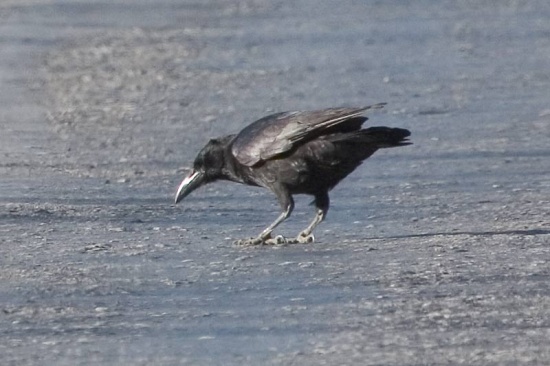- Corvus minutus
Includes: Hispaniolan Palm Crow; Cuban Palm Crow
Identification
34 - 38cm.
- Black plumage with purble-blue iridescence
- Brown iris
- Short, stout, sharp-pointed bill
- Gape ending in front of eye
- Well-developed nasal bristles covering nostrils
Sexes similar, males larger than females. Juveniles are duller than adults.
Similar Species
Confusingly similar to Cuban Crow. Voice is the key character. Differs as follows:
- has very different calls which are more "crow-like" (cf the strange, vaguely parrot-like calls of Cuban crow)
- gape of Palm Crow stops short of the eye; that of Cuban Crow extends to the middle of it at least
- Palm Crow is generally stated to have a shorter, less massive bill than Cuban Crow although this can be difficult to judge
- Palm Crow generally has more elongated feather tufts over the upper mandible compared with Cuban Crow. In the latter, the nasal tufts do not cover the nostrils.
- Palm Crow has a squared-off tail. Cuba Crow's is somewhat more rhomboidal with a curved rear edge
- Palm Crow has shorter wings. These give it a less ponderous flight action with faster and deeper wing beats. Cuban crow has a more fluttery flight where it may not raise its wings much above the horizontal
- Palm Crow may rest with wings held loosely by its sides. Cuban Crow often holds its wings with the tips crossing over the tail
- [reportedly] walks on the ground: Cuban Crow hops
- Palm Crow is smaller. Often difficult to judge in the field
Bill characters in particular seem variable and can be difficult to judge (at least based on ebird photos).
Distribution
Dominican Republic, Haiti and western Cuba.
Formerly abundant and still not uncommon on Hispaniola. Rare and local in Cuba, confined to Camaguey province now.
Taxonomy
Subspecies
Two subspeces recognized:
- C. m. minutus in Cuba
- C. m. palmarum on Hispaniola
Both subspecies are sometimes treated as full species.
Appears to be closely related to the Fish Crow of the eastern seaboard of the United States and also two smaller species, the Tamaulipas Crow and Sinaloa Crow of Mexico and forms a species group with them.
Habitat
Mountain pine forests, arid brush and hill country. Also in lowland cultivation with some palm trees. Often between 1300 - 1900m on Hispaniola.
Behaviour
Diet
Feeds on invertebrates (beetles, caterpillars, cicadas, snails), lizards and fruits. Usually foraging in pairs or small groups on the ground.
Breeding
Breeding season from March to July in Cuba. Obviously a solitary nester. The nest is made of sticks and placed among tree branches or in a palm tree. Lays 4 eggs. Breeding habits poorly known.
Movements
No information about movements.
References
- Clements, JF. 2011. The Clements Checklist of Birds of the World. 6th ed., with updates to August 2011. Ithaca: Cornell Univ. Press. ISBN 978-0801445019. Spreadsheet available at http://www.birds.cornell.edu/clementschecklist/downloadable-clements-checklist
- Del Hoyo, J, A Elliott, and D Christie, eds. 2009. Handbook of the Birds of the World. Volume 14: Bush-shrikes to Old World Sparrows. Barcelona: Lynx Edicions. ISBN 978-8496553507
- Birdforum thread discussing id of this species
Recommended Citation
- BirdForum Opus contributors. (2024) Palm Crow. In: BirdForum, the forum for wild birds and birding. Retrieved 27 July 2024 from https://www.birdforum.net/opus/Palm_Crow
External Links
GSearch checked for 2020 platform.1





